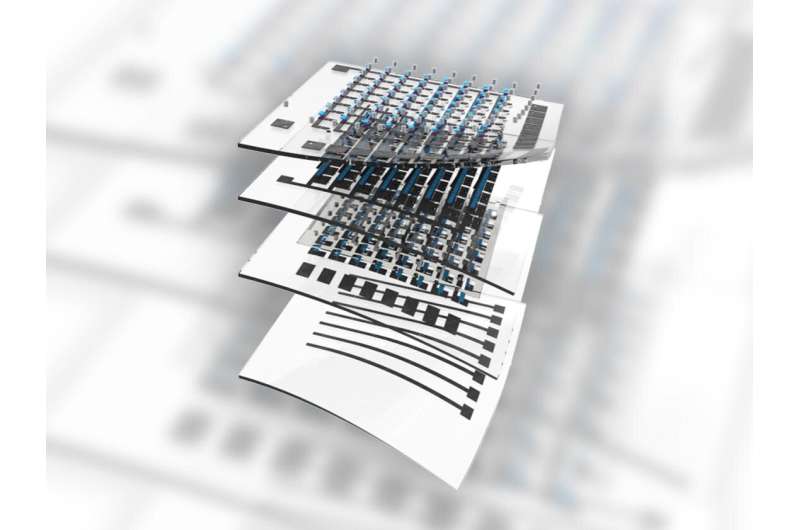This article has been reviewed according to Science X's editorial process and policies. Editors have highlighted the following attributes while ensuring the content's credibility:
fact-checked
peer-reviewed publication
trusted source
proofread
Stretchy integrated electronics may be possible with sandwiched semiconductor

There's a barrier preventing the advent of truly elastic electronic systems, the kind needed for advanced human-machine interfaces, artificial skins, smart health care and more, but a Penn State-led research team may have found a way to stretch around it.
According to principal investigator Cunjiang Yu, who is the Dorothy Quiggle Career Development Associate Professor of Engineering Science and Mechanics and of Biomedical Engineering at Penn State, fully elastic electronic systems require flexibility and stretchability in every component. Researchers have achieved this characteristic in most of the components, except for one type of semiconductor that is notoriously brittle. Now, Yu and his international team developed an approach to compensate for the frail and breakable semiconductor to advance the field closer to fully flexible systems.
They have published their work in Nature Electronics.
"Such technology requires stretchy elastic semiconductors, the core material needed to enable integrated circuits that are critical to the technology enabling our computers, phones and so much more, but these semiconductors are mainly p-type," said Yu, referring to a material that conducts electricity primarily through positively charged movable holes. "However, complementary integrated electronics, optoelectronics, p-n junction devices and many others also require an n-type semiconductor."
N-type semiconductors conduct electricity primarily through negative electrons carrying the charge, and in combination with p-type semiconductors, they can act as a switch, with current flowing in one direction. They are often rigid, and certain strategies to make them more mechanically stretchy are needed to achieve completely stretchable transistors and circuits with n-type semiconductors, according to Yu.
To address this issue, the researchers sandwiched the n-type semiconductor between two rubbery materials known as elastomers, which are polymers that can stretch and snap back to their original shape.
"We found that the stack architecture improves mechanical stretchability and suppresses the formation and propagation of microcracks in the intrinsically brittle n-type semiconductor," Yu said, explaining that microcracks are tiny structure defects that appear when the n-type semiconductor is stretched. They can degrade electrical performance and lead to mechanical failure.
The team put the stack through a gauntlet of stress and stability tests, all of which it passed with flying colors, Yu said. They also used the stack to fabricate stretchy transistors and integrated electronic systems.
"The elastic transistors retained high device performance even when stretched 50% in either direction," Yu said. "The devices also exhibited long-term stable operation for over 100 days in an ambient environment."
The stability in an ambient environment is particularly useful, according to Yu, because n-type semiconductors can lose efficiency with exposure to oxygen and moisture. Sandwiched between elastomers, the semiconductor is effectively encapsulated against the elements.
Next, Yu said, the team will continue to work to improve the performances of the stacked materials and optimize the layer configuration to further reduce the density of microcracks.
"Now we have a stretchy n-type semiconductor, and we will soon have stretchy rubbery integrated circuits," Yu said. "Isn't it exciting?"
More information: Hyunseok Shim et al, Elastic integrated electronics based on a stretchable n-type elastomer–semiconductor–elastomer stack, Nature Electronics (2023). DOI: 10.1038/s41928-023-00966-4




















